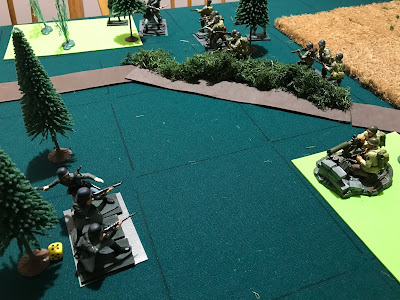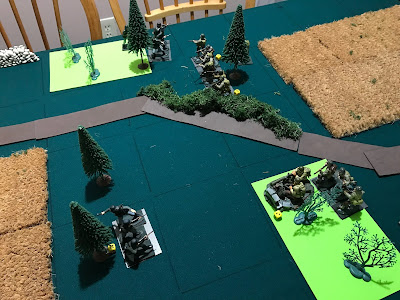Friday night I fought the third and final battle of the Bloody Omaha campaign from
Skirmish Campaigns:Heroes of Omaha and Panzer Lehr. The scenario is called "Grandcamp."
The scenario is set on June 8, as the 3rd Battalion of the 116th Regiment, 29th Infantry Division, made its way west of Point-du-Hoc and encountered elements of German 1st Battalion, 914th Infantry Regiment, 352nd Infantry Division.
 |
| The battle field. US enters from the right. |
The US objective is to move from east to west (right to left in the picture) and either capture the farm or exit a portion of the troops off the west edge. If they can do both, they earn a decisive victory. The Germans win by denying the US their victory conditions, and earn a decisive victory if a certain percentage of their troops survive the encounter.
 |
| The Germans, off map, awaiting their deployment. |
The PL and the rifle squad held the farm (I played the scenario twice - this report is the second. In the first game my blinds were too random and the Germans were scattered in ways not logical for winning the scenario. I also forgot a few scenario rules, and that the MGs were light and medium, not heavy).
Converting the order of battle, the Germans have a Platoon Leader, a rifle squad (each man armed with a panzerfaust -8 in total), an MMG team, an independent LMG team, and a PAK38 and crew. Lacking a PAK38 model, I used one of my Britains guns for a "close enough" match.
 |
| US advance is underway and cautious. |
The Americans had a PL in jeep, one Sherman, an MMG team, a forward observer for an 81mm mortar battery (10 fire missions), and a full platoon of three rifle squads - one with a bazooka.
The US got off to a slow start,with troops taking positions in the bocage trying to see any enemies using the next hedgerow for cover.
 |
| German LMG team fires on the American MMG. |
On their left, some suspicious greenery turned out to be occupied by the German independent LMG team, who opened fire and pinned the US MMG.
Having revealed themselves, they became a target for the tank, who advanced with the PL in the jeep. A few rounds of HMG fire and the German LMG was suppressed - and then inexplicably I sent the jeep and tank to flank the farm, and moved the MMG up to support the infantry advance on the right (also heading for the farm), leaving the LMG team to try to rally (it took them quite awhile but I would pay for it when they finally did).
 |
| PAK crew opens fire on the Americans. |
The Germans had a nasty surprise waiting for the American riflemen when they stepped out of the bocage into open ground - the PAK38 crew was pointed straight at them. One of the squads was suppressed (I kind of screwed up my own rules - ATGs can only damage a single unit, they don't damage all units in the space. It wasn't an issue here).
Firing from the safety of the bocage, the US rifles shot up the PAK crew with ease and then moved quickly, and recklessly towards the farm.
 |
| Tank assault on farm as infantry move up under fire. |
The infantry advanced straight into the line of fire of the German HMG, located in the fields north of the farm. Simultaneously, the American Forward Observer called down fire on the farm - and would do so repeatedly for 8 fire missions.
The Sherman and jeep, far more cautious than the infantry, moved slowly down the road revealing some blank blinds and then set sights on the farm.
A shoot out between the Sherman and the Germans inside the farm began - and while the Germans did manage to score a suppression eventually with their Panzerfaust, it was too little, too late and once rallied, the tank's main gun suppressed them in time for a heavy mortar barrage to rain down and take them out.
 |
| Sherman destroys German barbed wire. |
The US infantry got hung up a bit German MMG and the rallied LMG that eventually made it to the fight. Amazingly, the LMG team ended up suppressed and then close assaulted, still won its close assault and destroyed their attacker.
It took some doing, and the US lost two squads and their MMG as casualties, but once both German MG teams were suppressed, the remaining US squad occupied the farm, while the Sherman cleared the way for the US to advance to the west. The German position became untenable.
 |
| The US force continues their advance. |
The US made it off the table and I called the game a US victory after 8 turns of the allowed 12.
Since they could not both hold the farm and exit enough troops to satisfy both victory conditions, it wasn't a decisive victory, but it was enough to win the campaign.
****
While playing I found a few problems in my QRS, so I took the link down while I fix those. Also, for the first time I had runs of cards for one side or the other near double digits. This is fine for me,as I play solo, but clearly it's not something that would fly for two player games.I need to think on that a bit.
Overall, the campaign was a lot of fun, my rules gave enjoyable games even though they still need tweaking. The vehicle rules worked well - although I feel like tanks should be more devastating, so there may be more changes there. That said, I'm looking forward to playing the Crossfire 2x2 scenarios some more, and vehicles don't make an appearance there, so it may be awhile.





















































